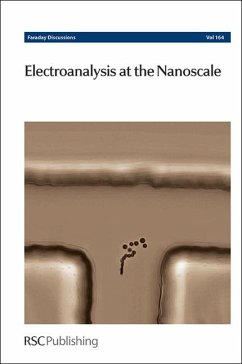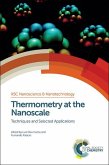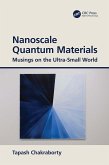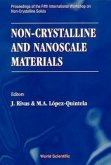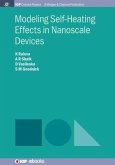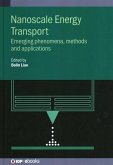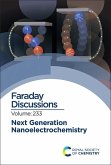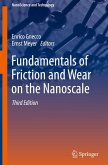Electroanalysis at the Nanoscale
Faraday Discussion 164
Electroanalysis at the Nanoscale
Faraday Discussion 164
- Gebundenes Buch
- Merkliste
- Auf die Merkliste
- Bewerten Bewerten
- Teilen
- Produkt teilen
- Produkterinnerung
- Produkterinnerung
The aim of this Faraday Discussion is to provide a forum with academic experts and end-users covering the interface between academic research and application.
Andere Kunden interessierten sich auch für
![Thermometry at the Nanoscale Thermometry at the Nanoscale]() Thermometry at the Nanoscale274,99 €
Thermometry at the Nanoscale274,99 €![Nanoscale Quantum Materials Nanoscale Quantum Materials]() Tapash ChakrabortyNanoscale Quantum Materials131,99 €
Tapash ChakrabortyNanoscale Quantum Materials131,99 €![Non-Crystalline and Nanoscale Materials - Proceedings of the Fifth International Workshop on Non-Crystalline Solids Non-Crystalline and Nanoscale Materials - Proceedings of the Fifth International Workshop on Non-Crystalline Solids]() Non-Crystalline and Nanoscale Materials - Proceedings of the Fifth International Workshop on Non-Crystalline Solids273,99 €
Non-Crystalline and Nanoscale Materials - Proceedings of the Fifth International Workshop on Non-Crystalline Solids273,99 €![Modeling Self-Heating Effects in Nanoscale Devices Modeling Self-Heating Effects in Nanoscale Devices]() Katerina RalevaModeling Self-Heating Effects in Nanoscale Devices137,99 €
Katerina RalevaModeling Self-Heating Effects in Nanoscale Devices137,99 €![Nanoscale Energy Transport Nanoscale Energy Transport]() Nanoscale Energy Transport215,99 €
Nanoscale Energy Transport215,99 €![Next Generation Nanoelectrochemistry Next Generation Nanoelectrochemistry]() Next Generation Nanoelectrochemistry254,99 €
Next Generation Nanoelectrochemistry254,99 €![Fundamentals of Friction and Wear on the Nanoscale Fundamentals of Friction and Wear on the Nanoscale]() Fundamentals of Friction and Wear on the Nanoscale150,99 €
Fundamentals of Friction and Wear on the Nanoscale150,99 €-
-
-
The aim of this Faraday Discussion is to provide a forum with academic experts and end-users covering the interface between academic research and application.
Hinweis: Dieser Artikel kann nur an eine deutsche Lieferadresse ausgeliefert werden.
Hinweis: Dieser Artikel kann nur an eine deutsche Lieferadresse ausgeliefert werden.
Produktdetails
- Produktdetails
- Verlag: RSC Publishing
- Seitenzahl: 448
- Erscheinungstermin: 19. Dezember 2013
- Englisch
- Abmessung: 236mm x 165mm x 30mm
- Gewicht: 794g
- ISBN-13: 9781849736916
- ISBN-10: 184973691X
- Artikelnr.: 38055828
- Herstellerkennzeichnung
- Libri GmbH
- Europaallee 1
- 36244 Bad Hersfeld
- gpsr@libri.de
- Verlag: RSC Publishing
- Seitenzahl: 448
- Erscheinungstermin: 19. Dezember 2013
- Englisch
- Abmessung: 236mm x 165mm x 30mm
- Gewicht: 794g
- ISBN-13: 9781849736916
- ISBN-10: 184973691X
- Artikelnr.: 38055828
- Herstellerkennzeichnung
- Libri GmbH
- Europaallee 1
- 36244 Bad Hersfeld
- gpsr@libri.de
Faraday Discussions documents a long-established series of Faraday Discussion meetings which provide a unique international forum for the exchange of views and newly acquired results in developing areas of physical chemistry, biophysical chemistry and chemical physics. The papers presented are published in the Faraday Discussion volume together with a record of the discussion contributions made at the meeting. Faraday Discussions therefore provide an important record of current international knowledge and views in the field concerned. The latest (2012) impact factor of Faraday Discussions is 3.82.
Introductory Lecture; Session 1: Bioelectroanalysis; Microelectrochemical
visualization of oxygen consumption of single living cells; Vesicular
release of neurotransmitters:converting amperometric measurements into
size, dynamics and energetics of initial fusion pores; Potential-dependent
single molecule blinking dynamics for flavin adenine dinucleotide
covalently immobilized in zero-mode waveguide array of working electrodes;
Networks of DNA-templated palladium nanowires:structural and electrical
characterisation and their use as hydrogen gas sensors;Session 2:
Nanomaterial platforms; Anodic TiO2 nanotubes: double walled vs. single
walled; The simplest model of charge storage in single file metallic
nanopores; Carbon nanotube based electrochemical sensor for the sensitive
detection of valacyclovire; Electroanalysis using modified hierarchical
nanoporous carbon materials; Pd-Au core-shell nanocrystals with concave
cubic shapes: kinetically controlled synthesis and electrocatalytic
properties; Electrochemical mechanicalmicromachining based on confirmed
etchant layer technique; Decoration of active sites to create bimetallic
surfaces and its implication for electrochemical processes; Session 3:
Chemical detection; Mapping fluxes of radicals from the combination of
electrochemical activation and optical microscopy; Electrochemically
assisted self-assembly of functionalized mesoporous silica films: impact of
the electrode geometry and size on film formation and properties; Metallic
Impurities Availability in Reduced Graphene is Greatly Enhanced by its
Ultrasonication; Highly Sensitive Detection of Nitroaromatic Explosives at
Discrete Nanowire Arrays; A systematic study of the influence of
nanoelectrode dimensions on electrode performance and the implications for
electroanalysis and sensing; Session 4: Charge transer at the nanoscale;
Double layer effects at nanosized electrodes; Pulse electroanalysis at
gold-gold micro-trench electrodes: Chemical signal filtering; Effects of
adsorption and confinement on nanoporous electrochemistry; Gold nanowire
electrodes in array: simulation study and experiments; Nanoscale control
interfacial processes for latent fingerprint enhancement; Closing remarks
lecture
visualization of oxygen consumption of single living cells; Vesicular
release of neurotransmitters:converting amperometric measurements into
size, dynamics and energetics of initial fusion pores; Potential-dependent
single molecule blinking dynamics for flavin adenine dinucleotide
covalently immobilized in zero-mode waveguide array of working electrodes;
Networks of DNA-templated palladium nanowires:structural and electrical
characterisation and their use as hydrogen gas sensors;Session 2:
Nanomaterial platforms; Anodic TiO2 nanotubes: double walled vs. single
walled; The simplest model of charge storage in single file metallic
nanopores; Carbon nanotube based electrochemical sensor for the sensitive
detection of valacyclovire; Electroanalysis using modified hierarchical
nanoporous carbon materials; Pd-Au core-shell nanocrystals with concave
cubic shapes: kinetically controlled synthesis and electrocatalytic
properties; Electrochemical mechanicalmicromachining based on confirmed
etchant layer technique; Decoration of active sites to create bimetallic
surfaces and its implication for electrochemical processes; Session 3:
Chemical detection; Mapping fluxes of radicals from the combination of
electrochemical activation and optical microscopy; Electrochemically
assisted self-assembly of functionalized mesoporous silica films: impact of
the electrode geometry and size on film formation and properties; Metallic
Impurities Availability in Reduced Graphene is Greatly Enhanced by its
Ultrasonication; Highly Sensitive Detection of Nitroaromatic Explosives at
Discrete Nanowire Arrays; A systematic study of the influence of
nanoelectrode dimensions on electrode performance and the implications for
electroanalysis and sensing; Session 4: Charge transer at the nanoscale;
Double layer effects at nanosized electrodes; Pulse electroanalysis at
gold-gold micro-trench electrodes: Chemical signal filtering; Effects of
adsorption and confinement on nanoporous electrochemistry; Gold nanowire
electrodes in array: simulation study and experiments; Nanoscale control
interfacial processes for latent fingerprint enhancement; Closing remarks
lecture
Introductory Lecture; Session 1: Bioelectroanalysis; Microelectrochemical
visualization of oxygen consumption of single living cells; Vesicular
release of neurotransmitters:converting amperometric measurements into
size, dynamics and energetics of initial fusion pores; Potential-dependent
single molecule blinking dynamics for flavin adenine dinucleotide
covalently immobilized in zero-mode waveguide array of working electrodes;
Networks of DNA-templated palladium nanowires:structural and electrical
characterisation and their use as hydrogen gas sensors;Session 2:
Nanomaterial platforms; Anodic TiO2 nanotubes: double walled vs. single
walled; The simplest model of charge storage in single file metallic
nanopores; Carbon nanotube based electrochemical sensor for the sensitive
detection of valacyclovire; Electroanalysis using modified hierarchical
nanoporous carbon materials; Pd-Au core-shell nanocrystals with concave
cubic shapes: kinetically controlled synthesis and electrocatalytic
properties; Electrochemical mechanicalmicromachining based on confirmed
etchant layer technique; Decoration of active sites to create bimetallic
surfaces and its implication for electrochemical processes; Session 3:
Chemical detection; Mapping fluxes of radicals from the combination of
electrochemical activation and optical microscopy; Electrochemically
assisted self-assembly of functionalized mesoporous silica films: impact of
the electrode geometry and size on film formation and properties; Metallic
Impurities Availability in Reduced Graphene is Greatly Enhanced by its
Ultrasonication; Highly Sensitive Detection of Nitroaromatic Explosives at
Discrete Nanowire Arrays; A systematic study of the influence of
nanoelectrode dimensions on electrode performance and the implications for
electroanalysis and sensing; Session 4: Charge transer at the nanoscale;
Double layer effects at nanosized electrodes; Pulse electroanalysis at
gold-gold micro-trench electrodes: Chemical signal filtering; Effects of
adsorption and confinement on nanoporous electrochemistry; Gold nanowire
electrodes in array: simulation study and experiments; Nanoscale control
interfacial processes for latent fingerprint enhancement; Closing remarks
lecture
visualization of oxygen consumption of single living cells; Vesicular
release of neurotransmitters:converting amperometric measurements into
size, dynamics and energetics of initial fusion pores; Potential-dependent
single molecule blinking dynamics for flavin adenine dinucleotide
covalently immobilized in zero-mode waveguide array of working electrodes;
Networks of DNA-templated palladium nanowires:structural and electrical
characterisation and their use as hydrogen gas sensors;Session 2:
Nanomaterial platforms; Anodic TiO2 nanotubes: double walled vs. single
walled; The simplest model of charge storage in single file metallic
nanopores; Carbon nanotube based electrochemical sensor for the sensitive
detection of valacyclovire; Electroanalysis using modified hierarchical
nanoporous carbon materials; Pd-Au core-shell nanocrystals with concave
cubic shapes: kinetically controlled synthesis and electrocatalytic
properties; Electrochemical mechanicalmicromachining based on confirmed
etchant layer technique; Decoration of active sites to create bimetallic
surfaces and its implication for electrochemical processes; Session 3:
Chemical detection; Mapping fluxes of radicals from the combination of
electrochemical activation and optical microscopy; Electrochemically
assisted self-assembly of functionalized mesoporous silica films: impact of
the electrode geometry and size on film formation and properties; Metallic
Impurities Availability in Reduced Graphene is Greatly Enhanced by its
Ultrasonication; Highly Sensitive Detection of Nitroaromatic Explosives at
Discrete Nanowire Arrays; A systematic study of the influence of
nanoelectrode dimensions on electrode performance and the implications for
electroanalysis and sensing; Session 4: Charge transer at the nanoscale;
Double layer effects at nanosized electrodes; Pulse electroanalysis at
gold-gold micro-trench electrodes: Chemical signal filtering; Effects of
adsorption and confinement on nanoporous electrochemistry; Gold nanowire
electrodes in array: simulation study and experiments; Nanoscale control
interfacial processes for latent fingerprint enhancement; Closing remarks
lecture

